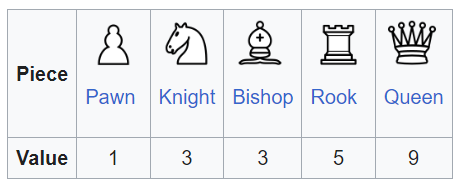
Bishop vs Knight
With many new players at beginner level joining AIWCF, it is worthwhile to provide articles that explain basic principles. Even players at a higher level are sometimes puzzled in evaluating Bishop versus Knight positions. In this article I explain some aspects of this important topic. The examples are tailored to over the board play and engine forbidden CC. (If engines are allowed, today’s chess programs know how to handle B vs N positions).
One of the first things you learn while starting chess is the relative values of the pieces:

Then you may hear that B is slightly superior to N and so B should probably be considered 3.25. Some beginners think that N is superior because it can jump over pieces, move to squares of both colours, and create forks. When you study master games, you notice the trade of Bishop for Knight often takes place early in the game and it looks like B and N are being considered equal and exchanged without any thought. Some astute beginners are quick to notice that among the elementary mates 2B+K vs. K wins easily, B+N+K vs. K also wins but takes more effort while 2N+K vs K does not win.
The reason why the Bishop is considered superior to the Knight is because of its longer reach. The Knight with its agile leap is considered useful in the middle game, but when the end-game approaches (barring exceptional positions) the Bishop is definitely better. Although we will see that Knights can sometimes be better than Bishops, the superiority of the Bishop over Knight is recognized and when you capture your opponent’s Bishop in exchange for your Knight, you are said to have won the “minor exchange.” This term “minor exchange” is used to distinguish it from “winning the exchange” (Rook in exchange for Bishop or Knight).
Most beginners, once they learn the relative values of the pieces (taking Bishop=3.25) think they now have an easy formula and can decide on piece exchanges in any situation. This is where they go wrong. The relative values of the pieces depends on the position and there are many exceptions. The first type of exception is tactical. Tactical considerations cover cases where material advantage or checkmate results after sacrificing material. Positional or strategic considerations cover cases where nothing immediate is happening, but one player achieves better prospects in the long run. In this article we will only talk about strategical imbalances in Bishop versus Knight positions.
Bishops are better than knights if the position is open. This is particularly so in the endgame, because many endgames are open positions. The Bishop Pair (2B vs B+N or 2B vs 2N) often constitutes a dominating advantage. In contrast, Knights can be powerful if centrally placed. This applies in the middle game, but there are endgame positions where the Knight can be better than a Bishop. A classic case is when both sides have pawns on the same flank (Kingside or Queenside). In this case, play is on either the left-half or right-half of the board and the longer reach of the Bishop is not relevant. Moreover, with pawns facing each other, there is likelihood of the pawns becoming interlocked when the knight will be superior.
Position 1
Let us see how the Bishop is better in open endgame positions with play on both flanks.
In Bishop vs Knight positions, beginners are often confused about placing their pawns correctly. If I have a Bishop moving on light coloured squares, should I place my own pawns on light coloured squares so that they can be defended, or should I try to keep my pawns on dark coloured squares so that my Bishop has mobility? The answer is, try to place your pawns on the opposite colour squares of your Bishop. When we reach the endgame, the pawns will interlock leaving the opponents pawns on the same colour squares as your Bishop and susceptible to attack.
Position 2
In the position below, the N is superior to the B:
Position 3
In the position below, the N is vastly superior to the B, but the winning method needs to be explained.
Now let us look at some games from actual play. In both cases the B vs N position is actually equal to start with. With correct play the player with the N could have held the position. However, the player with the Bishop found a way to achieve victory. While looking at these positions you are advised to take a two-step approach. First look at the position without calculating any concrete moves. Ask yourself: Is one side better than the other? Apply all the general principles of chess like Force, Mobility, Centre Control, Pawn Structure, Tempo/Development, Attack, not just the Bishop versus Knight principles explained in this article. After having made the assessment, try to work out specific moves. What is the way to create problems and challenges for the opponent?
Position 4
Space/Mobility: Count the available safe squares for all the pieces (not the pawns)
White: Q:3, R(d1):5, R(g1):5, B:3 Total:16
Black: Q:10, R(a7):5, R(f8):2, N:2 Total: 19
Centre Control: White’s pawns at e3 and f2 provide a minimum level of centre control while Black’s Queen dominates the centre
Pawn Structure: White has 3 pawn islands while Black has only 2
Tempo/Development: All of White’s pieces are well developed, but Black’s Knight is still on its original square
Attack: It is a position with opposite side castling. Black has a pawn storm going on the Q-side. White has given up a pawn on the K-side to create a semi-open g-file that targets Black’s King. The White Bishop on c3 is menacing along the long diagonal.
Bishop vs Knight: White’s Bishop is vastly superior to the poorly placed Black Knight. Presently White has 3 Pawns on the same colour square as his Bishop and only one Pawn on a light-coloured square. However, these pawns are still mobile.
Our objective assessment therefore would be that there are compensating factors making the position roughly equal. White’s attacking chances, and well-placed Bishop make up for his pawn deficit, lack of central control and slightly less mobility.
But in this game, in practical play, White won as follows:
Position 5
Our second example from practical play shows how Bobby Fischer one of the great proponents of Bishop versus Knight converts a win from a position that is objectively equal.
I do hope some of our new members would have liked this article. Do send me your feedback on DrAmbar@gmail.com